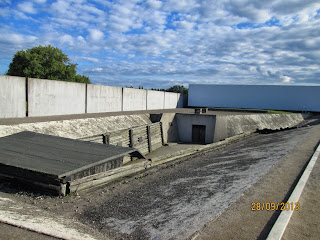The recent unveiling of The White Queen television series prompted
me to read Gregory’s book. Herewith my analysis of both.
The White Queen: On paper
As you know I do enjoy Gregory’s historical novels. I always
enjoy the way women are at the centre of her narrative; providing a fresh
perspective to historical events where women are portrayed as agents of change in a
traditionally male context. This is particularly the case in The White Queen which takes place at the courts of the fifteenth century York kings.
We return to a familiar cast for this novel; Mary Beaufort, Elizabeth
Woodville and Anne Neville, and to familiar themes; the role of fate, the secret
agency of women, and the power of gossip in the courts of kings. It was really
interesting to read accounts of common events from all three novels, such as the Battles of Towton
and Barnet through a second character’s eyes, having already read the narrative
from Anne Neville’s perspective (The Kingmaker's Daughter).
(Elizabeth Woodville discusses the situation with King Edward, image: BBC)
Variation from previous Gregory novels I have read include the use
of folklore as a counterpoint to the main narrative. Gregory borrows
extensively from the story of Melusina water-goddess with magic powers, said to be the ancestor of
the Burgundians, to illustrate the experience of the Woodville family and
Elizabeth Woodville specifically, from a second angle;
‘She [Melusina] knew that being a mortal woman is hard on the
heart and hard on the feet…He promised her that he would give her everything she
wanted, as men in love always do. And she trusted him despite herself, as women
in love always do’
Use of the Melusina narrative also enabled Gregory to explore the
perception of Woodville as witch; medieval philosophy credited witches with
real power to change situations with their craft, enabled only through
contracts with the devil. Throughout the novel Woodville uses witchcraft at key
moments in an attempt to change the progress of events.
I had some frustrations with this novel. The White Queen, whilst interacting first-hand with the popular story of the princes in the tower was otherwise plot-light; and not as rewarding as say, The Kingmaker’s Daughter. The story of Elizabeth Woodville involves plenty of time in
sanctuary waiting for men to succeed or fail in battle, revolt or be
suppressed. As a result the majority of the action in the novel happens on its periphery
or through the eyes of men in battle. There were several times I was tempted to
quit on this novel before the end; reading yet another chapter of Woodville in
sanctuary got boring!
The White Queen: On TV
With the recent ‘discovery of Richard III’ (I’m a sceptic) a TV drama surrounding the controversy of the princes in the tower is a no-brainer
for the BBC. Stretched over ten episodes, as opposed to the traditional 6-part
series, The White Queen attempts to synthesise three of Gregory’s novels into a
single series.
There are several successes to this series; there is plenty of
sex, violence and period costumes, all of these sell! Similarly, as I just mentioned, if there were ever to be a time when the general public were
interested in Richard III it would be now. In addition, I have stuck with the series
since episode 1 (despite a sensationally weak opening episodes) so something must be keeping my interest; perhaps it was the
unique decision to portray male monarchy through female eyes…
That said, there are several weaknesses to
representing this period of British monarchy on TV. Firstly, everyone has the same name
regardless of which side they are on (and let’s face it lots of them swap!)
which makes the plot tricky to follow.
This situation is made all the more complicated by a decision to
blend three of Gregory’s novels into one series from multiple perspectives. I
can see that this might create added drama, and that creating three series from three
different perspectives would be dry. There are, however, reasons why Gregory
writes from one perspective at a time; I think one of these might be character
loyalty. From page one in Gregory’s novels we watch events through one person’s
eyes; the drama of Warwick’s defeat at Barnet is uniquely painful through the
eyes of his daughter Anne Neville (The Kingmaker’s Daughter) or the departure
of the princes from sanctuary through Elizabeth Woodville’s (The White Queen). The
strength of feeling is definitely lost when the perspective on common events is
shared between the three women. I found very little compassion or interest for
Mary Beaufort (mother of Henry VII), for example, who is one of the three women who feature
in the series. I wonder if this is because, unlike the other two main characters, I haven’t read the narrative from
her perspective (The Red Queen) rather than because she is an intrinsically unlikable
character…
.jpg)
(Mary Beaufort as depicted in the series. Image: BBC)
In sum, I’d give the book maybe 6.5/10 (not as strong as The Kingmaker's Daughter) and the TV series 7/10 (with
at least one of those points dedicated to retaining my interest for 10
episodes!).
Catch The White Queen series and other related content on
BBC iPlayer this week.
I’ve read another really exciting book recently, Ann
Veronica by H G Wells; keep your eyes peeled for that!














































.jpg)






